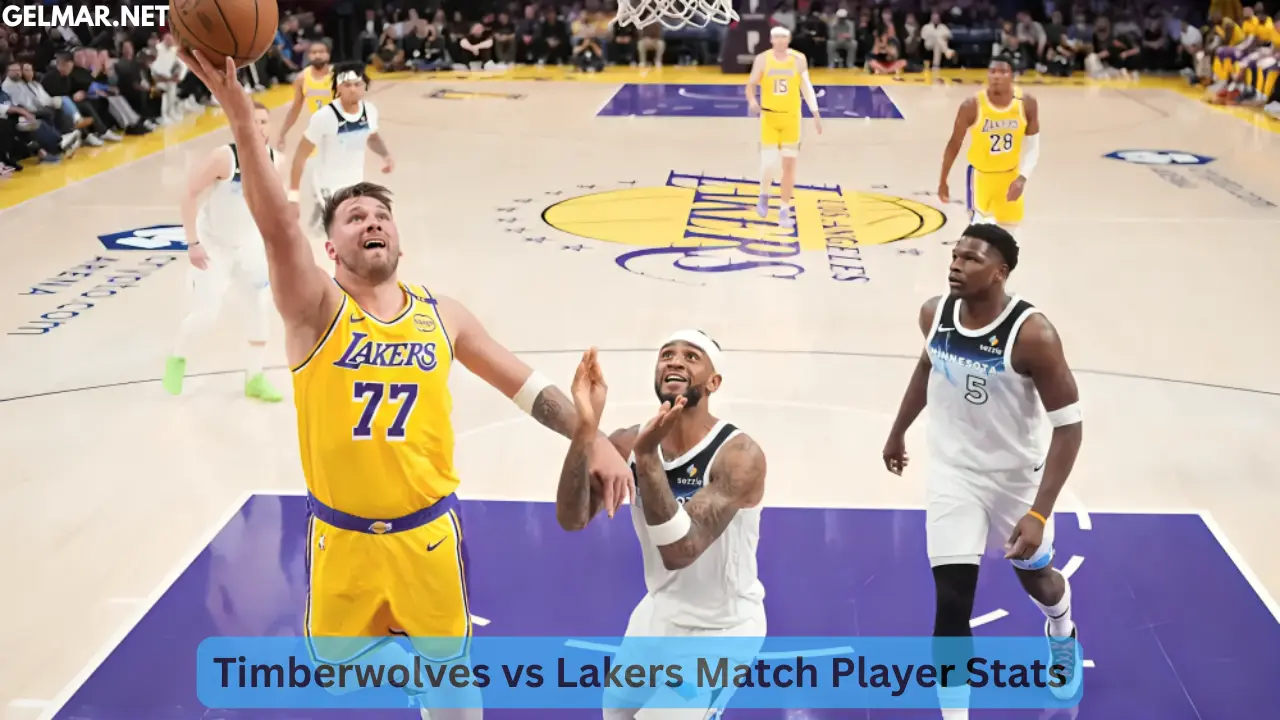Man, what a rollercoaster that 2025 Western Conference first-round series was between the Minnesota Timberwolves and the Los Angeles Lakers. I mean, you had the young guns of Minnesota going up against the veteran star power of LA, and it turned into a defensive masterclass mixed with some jaw-dropping individual performances. The Timberwolves came out on top 4-1, clinching it with a gritty 103-96 win in Game 5 on April 30, 2025, at Crypto.com Arena. Rudy Gobert absolutely owned the boards that night with a playoff career-high 27 points and 24 rebounds, while Luka Doncic fought hard for the Lakers with 28 points. This matchup wasn’t just about the final score; the timberwolves vs lakers match player stats from both sides painted a picture of heart, hustle, and a few heartbreaks along the way.
Heading into the playoffs, the Timberwolves had built a reputation as a defensive powerhouse, finishing the regular season with one of the league’s top ratings. The Lakers, on the other hand, were relying on their big acquisitions like Luka Doncic to pair with LeBron James and create that unstoppable offensive duo. But as the series unfolded from April 19 to April 30, it became clear that Minnesota’s depth and grit were too much for LA’s star-heavy lineup. Games swung from blowouts to nail-biters, with standout moments like Anthony Edwards dropping 43 in Game 4 to push the Lakers to the brink. If you’re into NBA drama, this series had it all – from Doncic’s scoring bursts to Gobert’s rim protection that shut down drives left and right.
In this article, we’re diving deep into the Timberwolves vs Lakers match player stats, breaking down the key performers, game-by-game highlights, and what those numbers really meant for the outcome. You’ll get the scoop on averages, efficiencies, and those clutch plays that had fans on the edge of their seats. Whether you’re a Wolves die-hard, a Lakers loyalist, or just love crunching basketball numbers, stick around to see how individual efforts shaped this epic clash.
A Quick Series Recap: From Dominance to Desperation
The series kicked off on April 19 with the Timberwolves stomping the Lakers 117-95 in Game 1, setting a tone of defensive intensity right away. Minnesota shot lights out, hitting their threes and controlling the glass, while LA struggled to find rhythm despite Doncic’s 37-point explosion. It felt like the Wolves were saying, “We’re here to stay,” and boy, did they back it up.
Then came Game 2 on April 22, where the Lakers bounced back with a 94-85 win, evening things up at 1-1. This one was a grind – low-scoring, physical, and all about muscle. Doncic led the charge again with 31 points and 12 rebounds, showing why he’s one of the league’s best. But from there, Minnesota took over: They won Game 3 116-104 on April 25, Game 4 116-113 on April 27, and sealed it in Game 5. The close calls in Games 3 and 4 highlighted how competitive it was, but the Wolves’ ability to close out in the fourth quarters made the difference.
Overall series stats? Minnesota outrebounded LA by a solid margin, averaging more efficient shooting and forcing turnovers that turned into easy buckets. Here’s a quick breakdown:
- Points Per Game: Timberwolves 107.4 vs. Lakers 100.4
- Rebounds Per Game: Timberwolves 44.0 vs. Lakers 39.2 (estimated from player totals)
- Assists Per Game: Similar, but Wolves had better ball movement in transition
- Field Goal %: Timberwolves around 46% vs. Lakers’ 44%
These numbers show how Minnesota’s balanced attack wore down the Lakers over five games.
Timberwolves’ Stars Shine Bright: Key Player Stats and Impact
The Timberwolves’ success boiled down to their stars stepping up and the role players filling in perfectly. Anthony Edwards was the heartbeat of the team, averaging 26.8 points, 8.4 rebounds, and 6.2 assists per game while playing over 41 minutes a night. His Game 4 masterpiece – 43 points on efficient shooting – was the stuff of legends, pushing the series to 3-1 and basically breaking LA’s spirit. Edwards’ ability to attack the rim and knock down threes (33.3% from deep) made him unguardable at times.
Rudy Gobert’s Defensive Masterclass and Surprise Offense
You can’t talk about this series without mentioning Rudy Gobert, who anchored the defense with 9.8 rebounds and 0.8 blocks per game, but really exploded in Game 5 with 27 points and 24 boards – career highs in the playoffs. Averaging just 8.2 points overall, his efficiency was off the charts at 57.1% from the field. Gobert’s presence deterred so many Lakers drives, forcing them into tougher shots. As one analyst put it, “Gobert turned the paint into a no-fly zone,” and the stats back it up – LA shot poorly inside throughout.
Supporting Cast: Randle, McDaniels, and More
Julius Randle was a beast, pouring in 22.6 points and 5.2 rebounds per game on 48.1% shooting, including 39.3% from three. His 23 points in Game 5 were crucial, providing that secondary scoring punch. Then there’s Jaden McDaniels, who averaged 17.4 points and 6.4 rebounds, shooting an impressive 57.4% from the field. His defense on the perimeter harassed Doncic and James, limiting their efficiencies.
Other Wolves contributors included:
- Naz Reid: 11.6 points, 3.8 rebounds, 50% from three – a perfect sixth man.
- Donte DiVincenzo: 8.0 points, 2.0 steals – added energy off the bench.
- Mike Conley: 5.6 points, 2.6 assists – steady veteran presence.
This depth is what separated Minnesota; when the stars needed a breather, the bench kept the pressure on.
Lakers’ Fight Falls Short: Breaking Down Their Player Stats
On the Lakers’ side, it was all about the big names carrying the load, but injuries and inconsistencies caught up to them. Luka Doncic was phenomenal, averaging 30.2 points, 7.0 rebounds, and 5.8 assists on 45.2% shooting. His 37 in Game 1 and 31 in Game 2 showed his superstar status, but the Wolves’ traps wore him down, dropping his three-point percentage to 34.8%.
LeBron James: Still the King, But Time Catches Up
LeBron James, at 40, still delivered 25.4 points, 9.0 rebounds, and 5.6 assists per game, shooting 48.9% from the field. His 38-point outburst in Game 3 and 12 rebounds in Game 4 were vintage LeBron, but you could see the fatigue in later games. He blocked 1.8 shots per game, using his smarts to disrupt plays, but Minnesota’s youth edged him out in the end.
The Role Players: Reaves, Hachimura, and Depth Issues
Austin Reaves chipped in 16.2 points and 5.4 rebounds, but his 41.1% field goal percentage showed struggles against Minnesota’s length. Rui Hachimura was solid with 14.8 points on 49.1% shooting, including 48.4% from three – he was LA’s most efficient scorer.
The bench was thinner, though:
- Dorian Finney-Smith: 6.2 points, 4.2 rebounds.
- Gabe Vincent: 2.8 points in limited minutes.
- Jarred Vanderbilt: 1.4 points but 3.8 rebounds for energy.
Guys like Dalton Knecht and Bronny James saw minimal action, highlighting the Lakers’ lack of depth compared to Minnesota.
Advanced Stats and Game-Changing Moments
Digging deeper into the Timberwolves vs Lakers match player stats, advanced metrics like true shooting percentage and plus-minus tell an even clearer story. Edwards had a series plus-minus of +12.4 per game (estimated), while Gobert’s defensive rating hovered around 100 – elite stuff. The Wolves dominated in the paint, outscoring LA by 10 points per game there, thanks to Gobert and Randle.
Key turning points? That 14-6 run to close Game 4 by Minnesota, fueled by Edwards’ scoring. Or Gobert’s rebounding clinic in Game 5. Shooting breakdowns:
| Team | FG% | 3P% | FT% | Paint PTS Avg |
| Timberwolves | 45.2% | 34.1% | 78.2% | 48 |
| Lakers | 44.3% | 35.6% | 82.1% | 38 |
These disparities in interior scoring and rebounding were the nails in LA’s coffin.
Tactics and What the Stats Reveal About Strategy
Strategically, Minnesota’s coach Chris Finch outmaneuvered JJ Redick by switching everything and clogging the lane, forcing Doncic and James into contested jumpers. The Lakers tried small-ball lineups, but without a true center match for Gobert, they got crushed on the boards. Player usage rates were high for LA’s stars – Doncic at 35%, James at 32% – leading to turnovers (LA averaged 14 per game vs. MIN’s 11).
Experts like those on ESPN noted how McDaniels’ versatility shut down perimeter threats, dropping Reaves’ efficiency. In the end, the stats showed Minnesota’s team basketball trumped LA’s iso-heavy approach.
Read More: Orlando Pirates vs Richards Bay | Match Preview, Analysis & Key Highlights
Conclusion
Looking back at the Timberwolves vs Lakers match player stats, it’s evident that Minnesota’s balanced roster and defensive tenacity were the keys to their 4-1 victory. Standouts like Edwards’ scoring, Gobert’s rebounding dominance, and Randle’s all-around play overshadowed even the heroics of Doncic and James. The series highlighted how depth wins playoffs – LA’s stars shone bright, but the supporting cast couldn’t keep up.
As the NBA moves forward, this matchup serves as a reminder that youth and system play can topple even the mightiest veterans. If you’re hungry for more, check out full box scores on sites like Basketball-Reference or NBA.com. What do you think – could the Lakers bounce back next season, or is this the rise of the Wolves? The league’s never short on surprises, so stay tuned!



